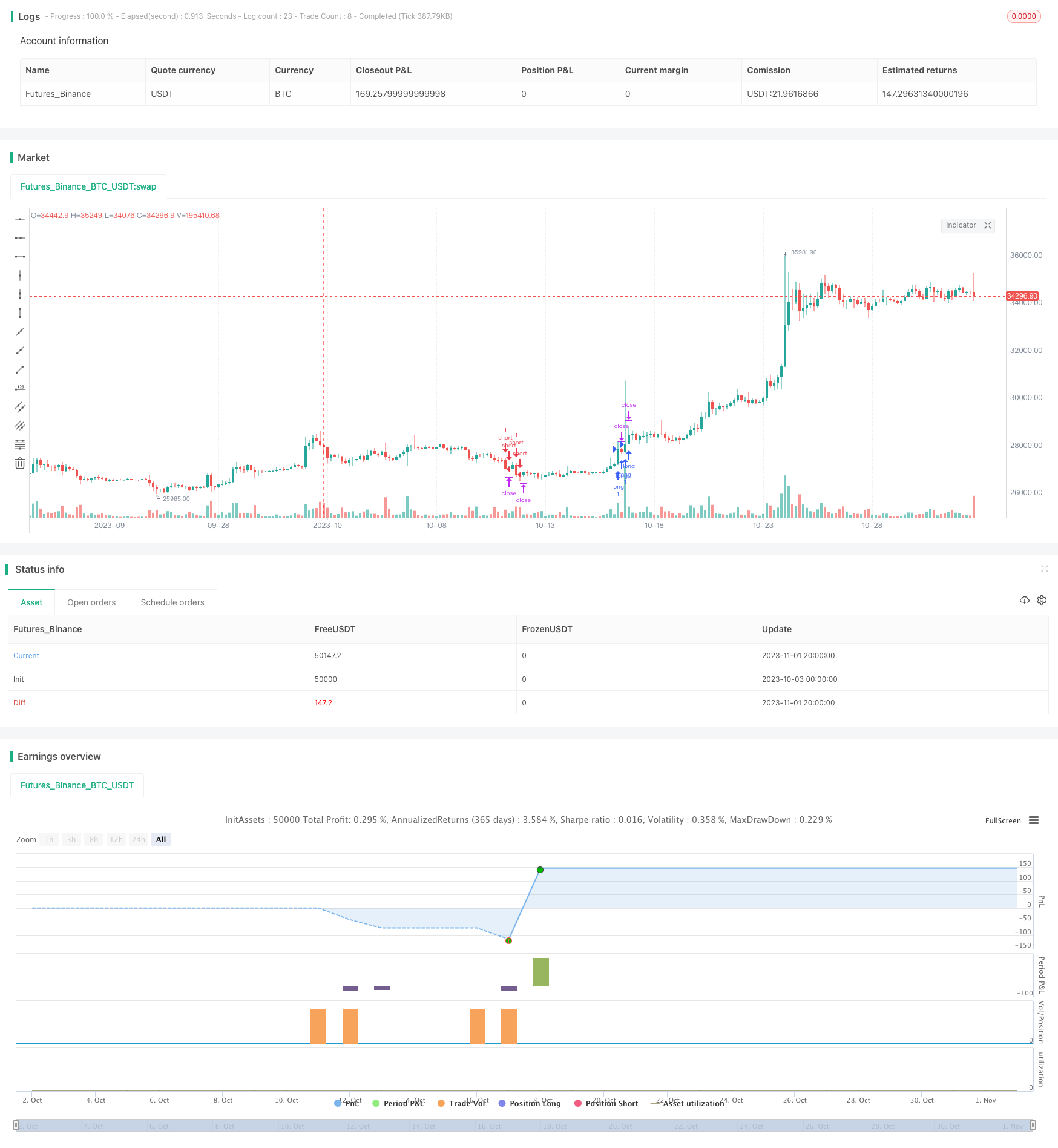
概述
RSI-BB动量突破策略是一个结合相对强弱指标(RSI)和布林带指标(BB)的突破策略。该策略利用RSI判断市场趋势和超买超卖现象,利用BB判断突破口,在RSI和BB指标同时发出买入或卖出信号时,进行相应的买入或卖出操作。
策略原理
代码中首先计算RSI和BB两个指标。
RSI的计算方法是:
up = rma(max(change(close), 0), 30)
down = rma(-min(change(close), 0), 30)
rsi = down == 0 ? 100 : up == 0 ? 0 : 100 - (100 / (1 + up / down))
其中up统计近30天收盘价上涨的幅度,down统计近30天收盘价下跌的幅度,rsi根据上涨幅度和下跌幅度的比值计算出来。
BB的计算方法是:
basis = sma(close, 50)
dev = 0.2 * stdev(close, 50)
upper = basis + dev
lower = basis - dev
其中basis是50日均线,dev是标准差的0.2倍,upper和lower分别是带中线上下轨。
bbi是布林带宽度指数,计算方法是:
bbr = close>upper? 1 : close<lower? -1 : 0
bbi = bbr - bbr[1]
bbr判断当前close是否突破上下轨,突破为1,跌破为-1,否则为0。bbi就是当前bbr减去前一周期bbr,大于0表示向上突破,小于0表示向下突破。
在计算出RSI和BBI后,策略的交易信号判断逻辑是:
long = rsi>52 and rsi<65 and bbi>0.11 and bbi<0.7
short = rsi<48 and rsi>35 and bbi<-0.11 and bbi>-0.7
也就是当RSI在52-65区间,且BBI大于0.11小于0.7时做多;当RSI在35-48区间,且BBI小于-0.11大于-0.7时做空。
策略优势
结合RSI和BB两个指标,能更准确判断买卖点。RSI判断超买超卖,BB判断突破口,两者结合更可靠。
RSI参数设置为30日线,可以过滤市场中的部分噪音,识别主要趋势。
BB参数设置为50日线以及0.2倍标准差,可以起到过滤震荡的效果。
BBI增加0.11和0.7的过滤条件,可以过滤假突破。
RSI的做多做空区间设置为52-65和35-48,增加buffer避免错失买卖点。
策略风险
突破交易策略容易被套,需要设置止损来控制风险。
回测数据可能存在过拟合,实盘效果可能会有差异。
市场可能出现剧烈变动,导致止损被击穿产生较大亏损。
需要优化RSI和BB的参数,包括周期参数及买卖区间参数。
订单的价格设置也会对实盘效果产生较大影响。
策略优化方向
测试不同的RSI和BB的参数组合,找到最佳参数。
添加其他指标判断过滤信号,如MACD、KD等。
优化和调整买卖的RSI区间参数,减小区间范围以过滤更多噪音。
优化BBI的过滤参数,设置动态区间过滤假突破。
添加趋势判断指标,避免逆势操作。
测试不同的止损方式,寻找最大回撤可接受的止损方案。
测试不同的订单方式,寻找滑点影响最小的下单方案。
总结
RSI-BB动量突破策略结合趋势判断和突破口判断的优点,在回测中表现不俗。但实盘效果可能会受滑点和止损的影响。需要针对回测结果优化参数,并测试不同的止损和下单方案,找到更适合实盘的设置。此外,参数和过滤条件都需要动态调整,才能应对市场的变化。总体来说,该策略有一定的实战价值,但需要持续优化和验证,才能产生稳定的效果。
/*backtest
start: 2023-10-03 00:00:00
end: 2023-11-02 00:00:00
period: 4h
basePeriod: 15m
exchanges: [{"eid":"Futures_Binance","currency":"BTC_USDT"}]
*/
//@version=4
//Based on Larry Connors RSI-2 Strategy - Lower RSI
strategy(title="Spyfrat Strat", shorttitle="SpyfratStrat", overlay=true)
src = close,
// BB Init
source = close
length = input(50, minval=1)
mult = input(0.2, title="Mult Factor", minval=0.001, maxval=50)
alertLevel=input(0.1)
impulseLevel=input(0.75)
showRange = input(false, type=bool)
//RSI CODE
up = rma(max(change(src), 0), 30)
down = rma(-min(change(src), 0), 30)
rsi = down == 0 ? 100 : up == 0 ? 0 : 100 - (100 / (1 + up / down))
//BB CODE
basis = sma(source, length)
dev = mult * stdev(source, length)
upper = basis + dev
lower = basis - dev
bbr = source>upper?(((source-upper)/(upper-lower))/10): source<lower?(((source-lower)/(upper-lower))/10) : 0.1
bbi = bbr - nz(bbr[1])
//Rule
long = rsi>52 and rsi<65 and bbi>0.11 and bbi<0.7
short = rsi<48 and rsi>35 and bbi<-0.11 and bbi>-0.7
//Trade Entry
strategy.entry("long", strategy.long, when=long)
strategy.entry("short", strategy.short, when=short)
//Trade Exit
TP = input(250) * 10
SL = input(20) * 10
TS = input(0) * 10
CQ = 100
TPP = (TP > 0) ? TP : na
SLP = (SL > 0) ? SL : na
TSP = (TS > 0) ? TS : na
strategy.exit("Close Long", "long", qty_percent=CQ, profit=TPP, loss=SLP, trail_points=TSP)
strategy.exit("Close Short", "short", qty_percent=CQ, profit=TPP, loss=SLP, trail_points=TSP)